Same Sex Marriage in Australia
VerifiedAdded on 2023/01/20
|9
|2774
|73
AI Summary
This article discusses the history and legalization of same sex marriage in Australia. It explores the societal and cultural perspectives, legal premise, and the struggle for acceptance. The passing of the law on same sex marriage in Australia was a revolutionary step in the country's history.
Contribute Materials
Your contribution can guide someone’s learning journey. Share your
documents today.
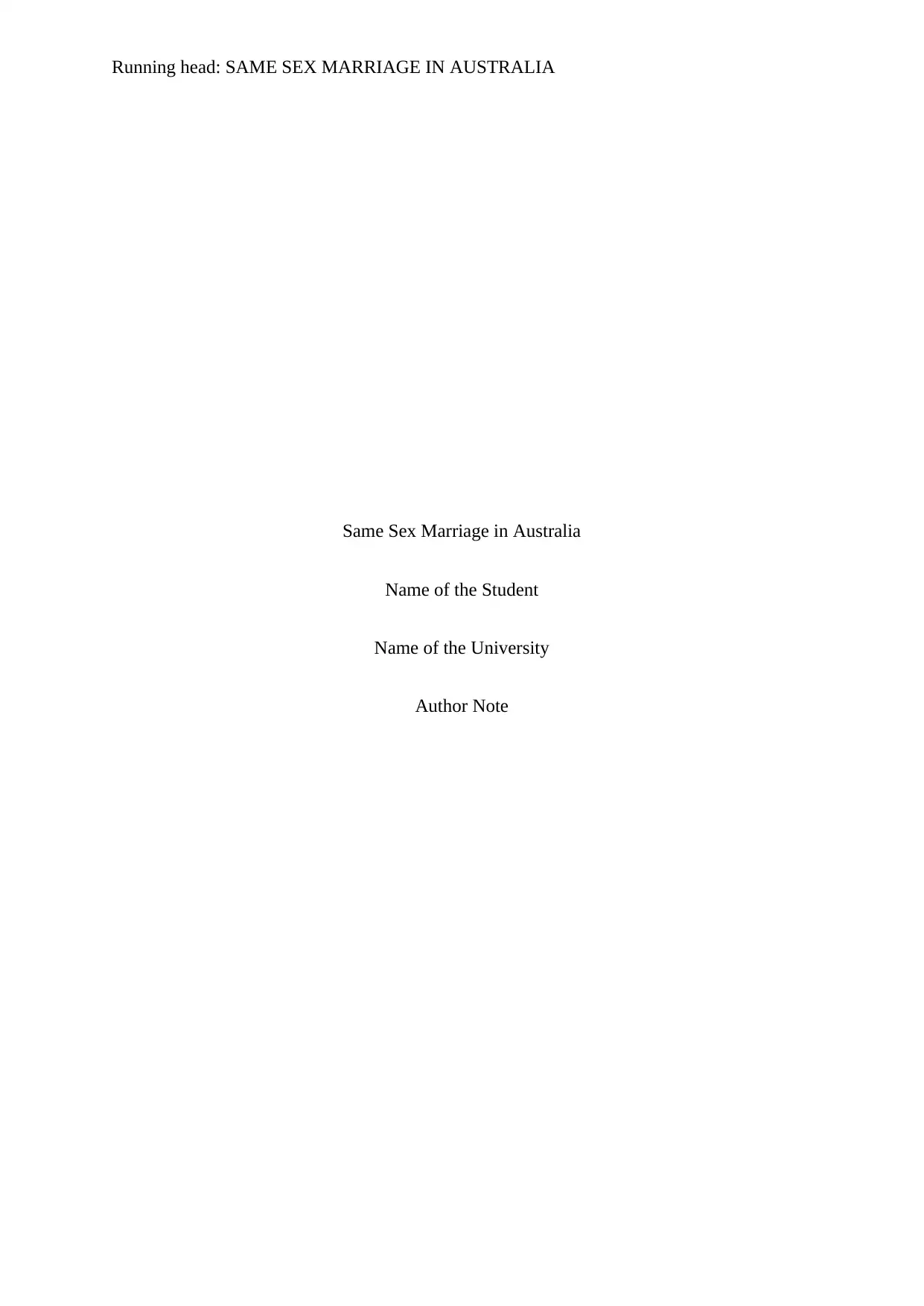
Running head: SAME SEX MARRIAGE IN AUSTRALIA
Same Sex Marriage in Australia
Name of the Student
Name of the University
Author Note
Same Sex Marriage in Australia
Name of the Student
Name of the University
Author Note
Secure Best Marks with AI Grader
Need help grading? Try our AI Grader for instant feedback on your assignments.
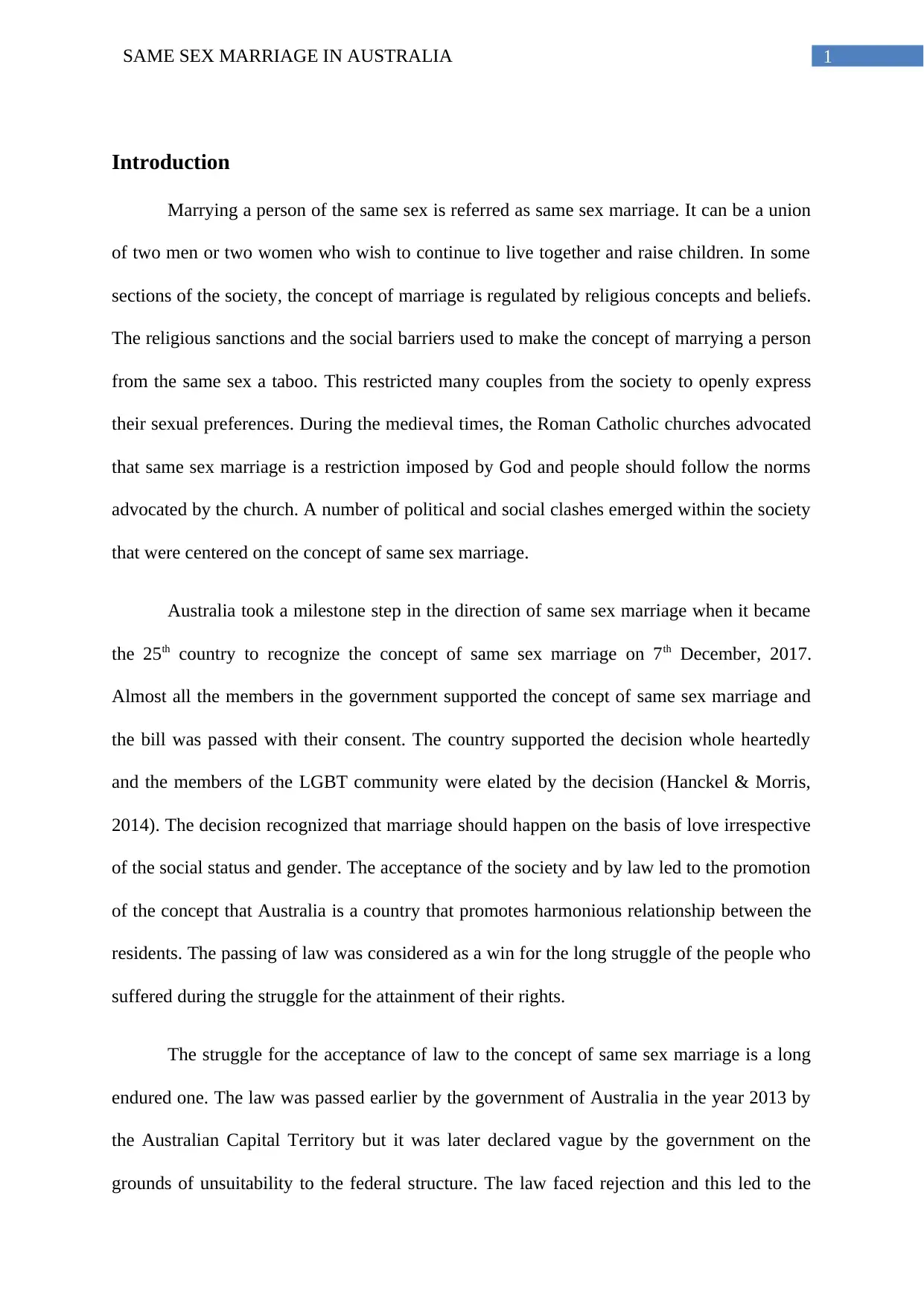
1SAME SEX MARRIAGE IN AUSTRALIA
Introduction
Marrying a person of the same sex is referred as same sex marriage. It can be a union
of two men or two women who wish to continue to live together and raise children. In some
sections of the society, the concept of marriage is regulated by religious concepts and beliefs.
The religious sanctions and the social barriers used to make the concept of marrying a person
from the same sex a taboo. This restricted many couples from the society to openly express
their sexual preferences. During the medieval times, the Roman Catholic churches advocated
that same sex marriage is a restriction imposed by God and people should follow the norms
advocated by the church. A number of political and social clashes emerged within the society
that were centered on the concept of same sex marriage.
Australia took a milestone step in the direction of same sex marriage when it became
the 25th country to recognize the concept of same sex marriage on 7th December, 2017.
Almost all the members in the government supported the concept of same sex marriage and
the bill was passed with their consent. The country supported the decision whole heartedly
and the members of the LGBT community were elated by the decision (Hanckel & Morris,
2014). The decision recognized that marriage should happen on the basis of love irrespective
of the social status and gender. The acceptance of the society and by law led to the promotion
of the concept that Australia is a country that promotes harmonious relationship between the
residents. The passing of law was considered as a win for the long struggle of the people who
suffered during the struggle for the attainment of their rights.
The struggle for the acceptance of law to the concept of same sex marriage is a long
endured one. The law was passed earlier by the government of Australia in the year 2013 by
the Australian Capital Territory but it was later declared vague by the government on the
grounds of unsuitability to the federal structure. The law faced rejection and this led to the
Introduction
Marrying a person of the same sex is referred as same sex marriage. It can be a union
of two men or two women who wish to continue to live together and raise children. In some
sections of the society, the concept of marriage is regulated by religious concepts and beliefs.
The religious sanctions and the social barriers used to make the concept of marrying a person
from the same sex a taboo. This restricted many couples from the society to openly express
their sexual preferences. During the medieval times, the Roman Catholic churches advocated
that same sex marriage is a restriction imposed by God and people should follow the norms
advocated by the church. A number of political and social clashes emerged within the society
that were centered on the concept of same sex marriage.
Australia took a milestone step in the direction of same sex marriage when it became
the 25th country to recognize the concept of same sex marriage on 7th December, 2017.
Almost all the members in the government supported the concept of same sex marriage and
the bill was passed with their consent. The country supported the decision whole heartedly
and the members of the LGBT community were elated by the decision (Hanckel & Morris,
2014). The decision recognized that marriage should happen on the basis of love irrespective
of the social status and gender. The acceptance of the society and by law led to the promotion
of the concept that Australia is a country that promotes harmonious relationship between the
residents. The passing of law was considered as a win for the long struggle of the people who
suffered during the struggle for the attainment of their rights.
The struggle for the acceptance of law to the concept of same sex marriage is a long
endured one. The law was passed earlier by the government of Australia in the year 2013 by
the Australian Capital Territory but it was later declared vague by the government on the
grounds of unsuitability to the federal structure. The law faced rejection and this led to the
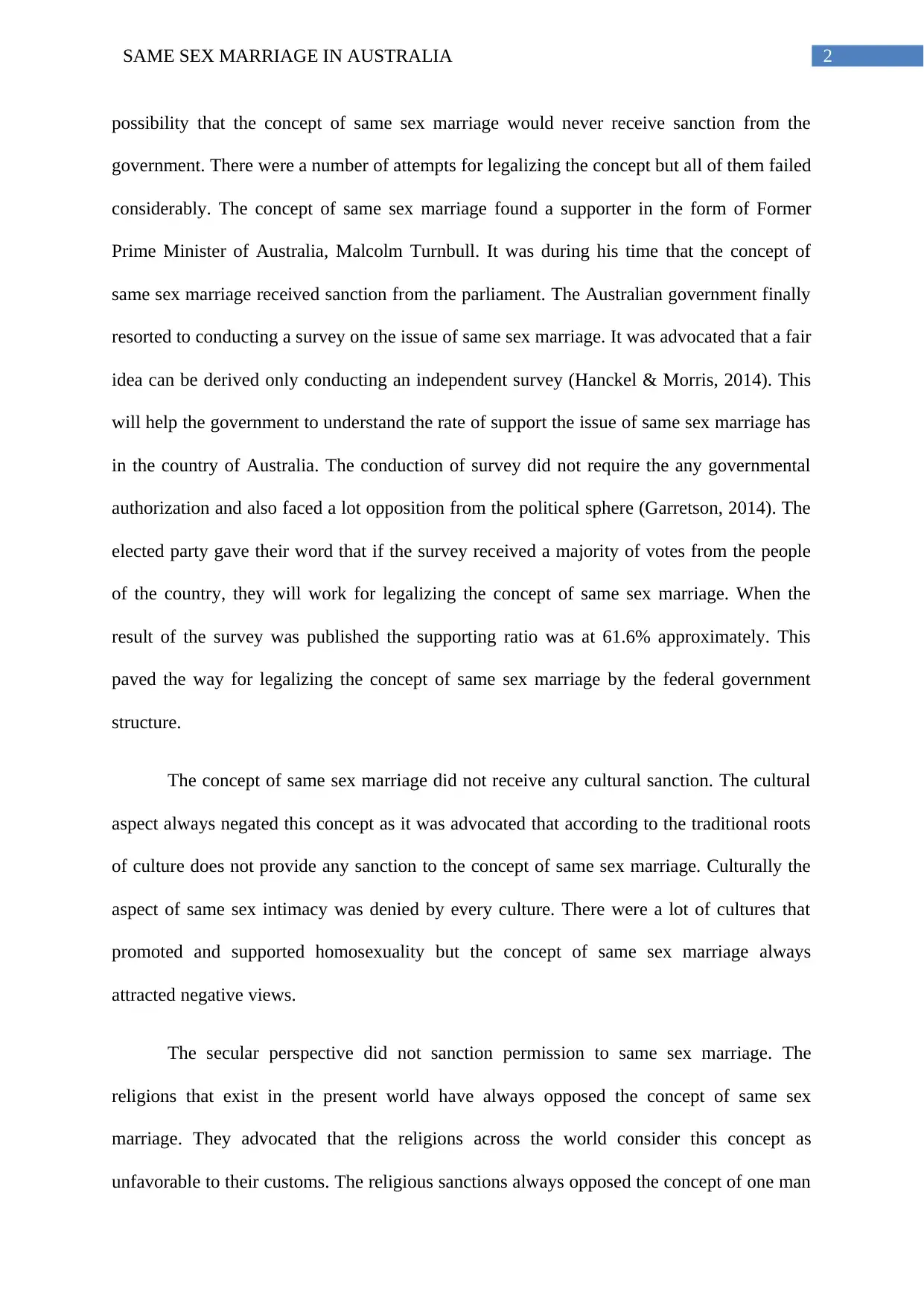
2SAME SEX MARRIAGE IN AUSTRALIA
possibility that the concept of same sex marriage would never receive sanction from the
government. There were a number of attempts for legalizing the concept but all of them failed
considerably. The concept of same sex marriage found a supporter in the form of Former
Prime Minister of Australia, Malcolm Turnbull. It was during his time that the concept of
same sex marriage received sanction from the parliament. The Australian government finally
resorted to conducting a survey on the issue of same sex marriage. It was advocated that a fair
idea can be derived only conducting an independent survey (Hanckel & Morris, 2014). This
will help the government to understand the rate of support the issue of same sex marriage has
in the country of Australia. The conduction of survey did not require the any governmental
authorization and also faced a lot opposition from the political sphere (Garretson, 2014). The
elected party gave their word that if the survey received a majority of votes from the people
of the country, they will work for legalizing the concept of same sex marriage. When the
result of the survey was published the supporting ratio was at 61.6% approximately. This
paved the way for legalizing the concept of same sex marriage by the federal government
structure.
The concept of same sex marriage did not receive any cultural sanction. The cultural
aspect always negated this concept as it was advocated that according to the traditional roots
of culture does not provide any sanction to the concept of same sex marriage. Culturally the
aspect of same sex intimacy was denied by every culture. There were a lot of cultures that
promoted and supported homosexuality but the concept of same sex marriage always
attracted negative views.
The secular perspective did not sanction permission to same sex marriage. The
religions that exist in the present world have always opposed the concept of same sex
marriage. They advocated that the religions across the world consider this concept as
unfavorable to their customs. The religious sanctions always opposed the concept of one man
possibility that the concept of same sex marriage would never receive sanction from the
government. There were a number of attempts for legalizing the concept but all of them failed
considerably. The concept of same sex marriage found a supporter in the form of Former
Prime Minister of Australia, Malcolm Turnbull. It was during his time that the concept of
same sex marriage received sanction from the parliament. The Australian government finally
resorted to conducting a survey on the issue of same sex marriage. It was advocated that a fair
idea can be derived only conducting an independent survey (Hanckel & Morris, 2014). This
will help the government to understand the rate of support the issue of same sex marriage has
in the country of Australia. The conduction of survey did not require the any governmental
authorization and also faced a lot opposition from the political sphere (Garretson, 2014). The
elected party gave their word that if the survey received a majority of votes from the people
of the country, they will work for legalizing the concept of same sex marriage. When the
result of the survey was published the supporting ratio was at 61.6% approximately. This
paved the way for legalizing the concept of same sex marriage by the federal government
structure.
The concept of same sex marriage did not receive any cultural sanction. The cultural
aspect always negated this concept as it was advocated that according to the traditional roots
of culture does not provide any sanction to the concept of same sex marriage. Culturally the
aspect of same sex intimacy was denied by every culture. There were a lot of cultures that
promoted and supported homosexuality but the concept of same sex marriage always
attracted negative views.
The secular perspective did not sanction permission to same sex marriage. The
religions that exist in the present world have always opposed the concept of same sex
marriage. They advocated that the religions across the world consider this concept as
unfavorable to their customs. The religious sanctions always opposed the concept of one man
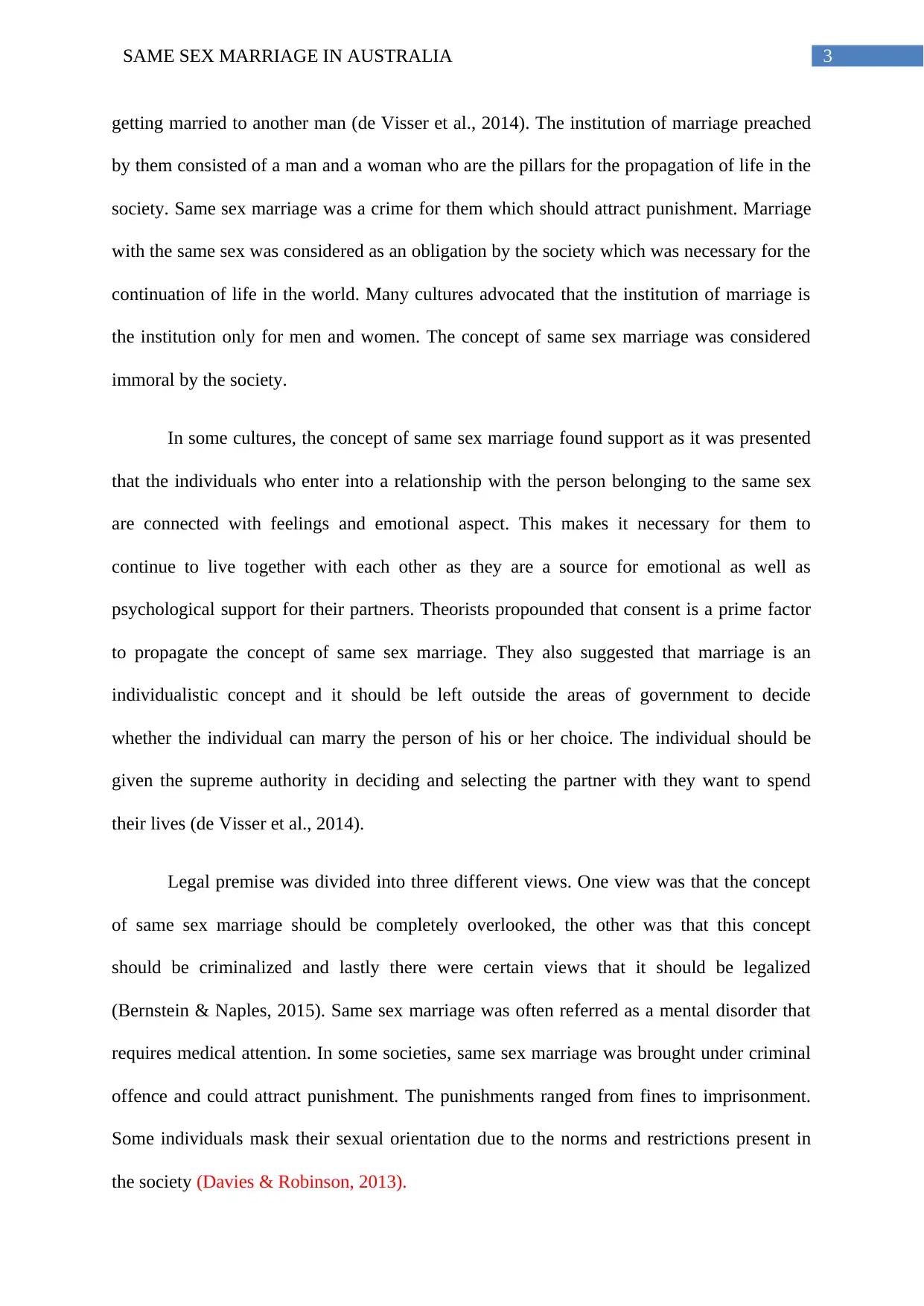
3SAME SEX MARRIAGE IN AUSTRALIA
getting married to another man (de Visser et al., 2014). The institution of marriage preached
by them consisted of a man and a woman who are the pillars for the propagation of life in the
society. Same sex marriage was a crime for them which should attract punishment. Marriage
with the same sex was considered as an obligation by the society which was necessary for the
continuation of life in the world. Many cultures advocated that the institution of marriage is
the institution only for men and women. The concept of same sex marriage was considered
immoral by the society.
In some cultures, the concept of same sex marriage found support as it was presented
that the individuals who enter into a relationship with the person belonging to the same sex
are connected with feelings and emotional aspect. This makes it necessary for them to
continue to live together with each other as they are a source for emotional as well as
psychological support for their partners. Theorists propounded that consent is a prime factor
to propagate the concept of same sex marriage. They also suggested that marriage is an
individualistic concept and it should be left outside the areas of government to decide
whether the individual can marry the person of his or her choice. The individual should be
given the supreme authority in deciding and selecting the partner with they want to spend
their lives (de Visser et al., 2014).
Legal premise was divided into three different views. One view was that the concept
of same sex marriage should be completely overlooked, the other was that this concept
should be criminalized and lastly there were certain views that it should be legalized
(Bernstein & Naples, 2015). Same sex marriage was often referred as a mental disorder that
requires medical attention. In some societies, same sex marriage was brought under criminal
offence and could attract punishment. The punishments ranged from fines to imprisonment.
Some individuals mask their sexual orientation due to the norms and restrictions present in
the society (Davies & Robinson, 2013).
getting married to another man (de Visser et al., 2014). The institution of marriage preached
by them consisted of a man and a woman who are the pillars for the propagation of life in the
society. Same sex marriage was a crime for them which should attract punishment. Marriage
with the same sex was considered as an obligation by the society which was necessary for the
continuation of life in the world. Many cultures advocated that the institution of marriage is
the institution only for men and women. The concept of same sex marriage was considered
immoral by the society.
In some cultures, the concept of same sex marriage found support as it was presented
that the individuals who enter into a relationship with the person belonging to the same sex
are connected with feelings and emotional aspect. This makes it necessary for them to
continue to live together with each other as they are a source for emotional as well as
psychological support for their partners. Theorists propounded that consent is a prime factor
to propagate the concept of same sex marriage. They also suggested that marriage is an
individualistic concept and it should be left outside the areas of government to decide
whether the individual can marry the person of his or her choice. The individual should be
given the supreme authority in deciding and selecting the partner with they want to spend
their lives (de Visser et al., 2014).
Legal premise was divided into three different views. One view was that the concept
of same sex marriage should be completely overlooked, the other was that this concept
should be criminalized and lastly there were certain views that it should be legalized
(Bernstein & Naples, 2015). Same sex marriage was often referred as a mental disorder that
requires medical attention. In some societies, same sex marriage was brought under criminal
offence and could attract punishment. The punishments ranged from fines to imprisonment.
Some individuals mask their sexual orientation due to the norms and restrictions present in
the society (Davies & Robinson, 2013).
Secure Best Marks with AI Grader
Need help grading? Try our AI Grader for instant feedback on your assignments.
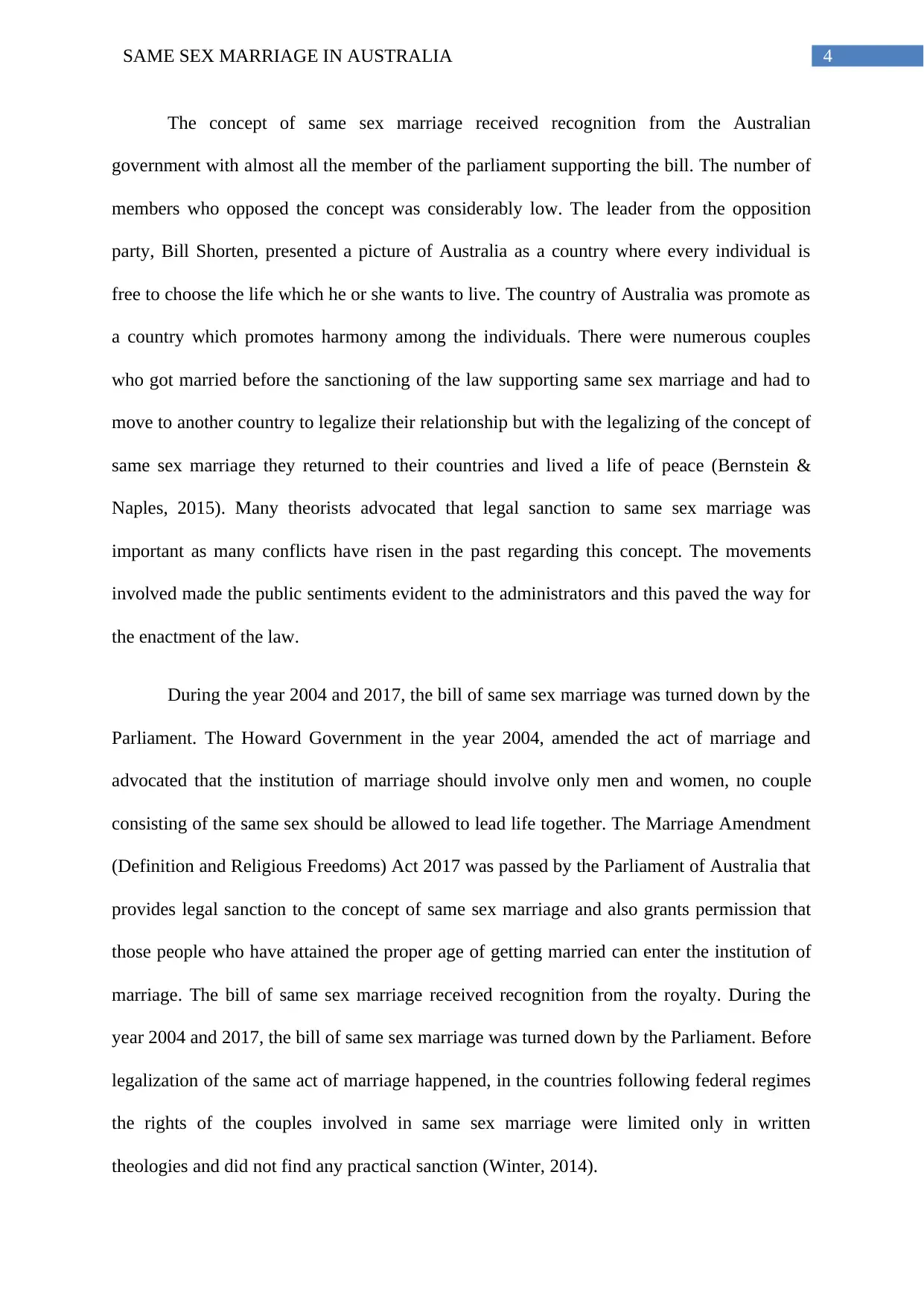
4SAME SEX MARRIAGE IN AUSTRALIA
The concept of same sex marriage received recognition from the Australian
government with almost all the member of the parliament supporting the bill. The number of
members who opposed the concept was considerably low. The leader from the opposition
party, Bill Shorten, presented a picture of Australia as a country where every individual is
free to choose the life which he or she wants to live. The country of Australia was promote as
a country which promotes harmony among the individuals. There were numerous couples
who got married before the sanctioning of the law supporting same sex marriage and had to
move to another country to legalize their relationship but with the legalizing of the concept of
same sex marriage they returned to their countries and lived a life of peace (Bernstein &
Naples, 2015). Many theorists advocated that legal sanction to same sex marriage was
important as many conflicts have risen in the past regarding this concept. The movements
involved made the public sentiments evident to the administrators and this paved the way for
the enactment of the law.
During the year 2004 and 2017, the bill of same sex marriage was turned down by the
Parliament. The Howard Government in the year 2004, amended the act of marriage and
advocated that the institution of marriage should involve only men and women, no couple
consisting of the same sex should be allowed to lead life together. The Marriage Amendment
(Definition and Religious Freedoms) Act 2017 was passed by the Parliament of Australia that
provides legal sanction to the concept of same sex marriage and also grants permission that
those people who have attained the proper age of getting married can enter the institution of
marriage. The bill of same sex marriage received recognition from the royalty. During the
year 2004 and 2017, the bill of same sex marriage was turned down by the Parliament. Before
legalization of the same act of marriage happened, in the countries following federal regimes
the rights of the couples involved in same sex marriage were limited only in written
theologies and did not find any practical sanction (Winter, 2014).
The concept of same sex marriage received recognition from the Australian
government with almost all the member of the parliament supporting the bill. The number of
members who opposed the concept was considerably low. The leader from the opposition
party, Bill Shorten, presented a picture of Australia as a country where every individual is
free to choose the life which he or she wants to live. The country of Australia was promote as
a country which promotes harmony among the individuals. There were numerous couples
who got married before the sanctioning of the law supporting same sex marriage and had to
move to another country to legalize their relationship but with the legalizing of the concept of
same sex marriage they returned to their countries and lived a life of peace (Bernstein &
Naples, 2015). Many theorists advocated that legal sanction to same sex marriage was
important as many conflicts have risen in the past regarding this concept. The movements
involved made the public sentiments evident to the administrators and this paved the way for
the enactment of the law.
During the year 2004 and 2017, the bill of same sex marriage was turned down by the
Parliament. The Howard Government in the year 2004, amended the act of marriage and
advocated that the institution of marriage should involve only men and women, no couple
consisting of the same sex should be allowed to lead life together. The Marriage Amendment
(Definition and Religious Freedoms) Act 2017 was passed by the Parliament of Australia that
provides legal sanction to the concept of same sex marriage and also grants permission that
those people who have attained the proper age of getting married can enter the institution of
marriage. The bill of same sex marriage received recognition from the royalty. During the
year 2004 and 2017, the bill of same sex marriage was turned down by the Parliament. Before
legalization of the same act of marriage happened, in the countries following federal regimes
the rights of the couples involved in same sex marriage were limited only in written
theologies and did not find any practical sanction (Winter, 2014).

5SAME SEX MARRIAGE IN AUSTRALIA
The monarchial sanction was given to the same sex marriage by the Governor-General on 8th
December 2017. This sanction guaranteed that the couples who were married outside the
jurisdiction of Australia can register their on the same date on which it happened. The
recognition brought back the couples who were estranged from their country due to the
restrictions imposed on them (Spade & Willse, 2016).
Dean Smith introduced took a historic step by introducing the bill on same sex
marriage in the Australian Senate. The bill provided equality on the basis of marriage
irrespective of gender discrimination. On behalf of the LGBT community, he advocated that
the problem with the concept of same sex marriage lies in self-acceptance (Morandini,
Blaszczynski, Dar‐Nimrod & Ross, 2015). There are people who often face issues while
presenting them to the society on the basis of their sexuality. According to him, the only
institution that can guarantee the acceptance of same sex relationship in the society is
marriage. The sanction of marriage can only guarantee that society will provide respect to the
couples as well as their children. The gay and lesbian rights in Australia were denied by the
society before the passing of this law (Garretson, 2014). The day the bill was passed it was
declared that the Australian nation should feel proud about their abilities and their nation that
recognizes the concept of same sex marriage. It was also suggested by legalizing the concept
of same sex marriage, it was evident that the Australian society is working with respect to the
relations the parents are having with their children. The psychological integration is also
increased with the openness the parents share with their children by discussing their sexual
preferences openly (Sabia, Wooden & Nguyen, 2017).
Conclusion
Thus, it can be concluded from the above discussion that after receiving much
opposition from the Australian society as well as government. Same sex marriage was
The monarchial sanction was given to the same sex marriage by the Governor-General on 8th
December 2017. This sanction guaranteed that the couples who were married outside the
jurisdiction of Australia can register their on the same date on which it happened. The
recognition brought back the couples who were estranged from their country due to the
restrictions imposed on them (Spade & Willse, 2016).
Dean Smith introduced took a historic step by introducing the bill on same sex
marriage in the Australian Senate. The bill provided equality on the basis of marriage
irrespective of gender discrimination. On behalf of the LGBT community, he advocated that
the problem with the concept of same sex marriage lies in self-acceptance (Morandini,
Blaszczynski, Dar‐Nimrod & Ross, 2015). There are people who often face issues while
presenting them to the society on the basis of their sexuality. According to him, the only
institution that can guarantee the acceptance of same sex relationship in the society is
marriage. The sanction of marriage can only guarantee that society will provide respect to the
couples as well as their children. The gay and lesbian rights in Australia were denied by the
society before the passing of this law (Garretson, 2014). The day the bill was passed it was
declared that the Australian nation should feel proud about their abilities and their nation that
recognizes the concept of same sex marriage. It was also suggested by legalizing the concept
of same sex marriage, it was evident that the Australian society is working with respect to the
relations the parents are having with their children. The psychological integration is also
increased with the openness the parents share with their children by discussing their sexual
preferences openly (Sabia, Wooden & Nguyen, 2017).
Conclusion
Thus, it can be concluded from the above discussion that after receiving much
opposition from the Australian society as well as government. Same sex marriage was
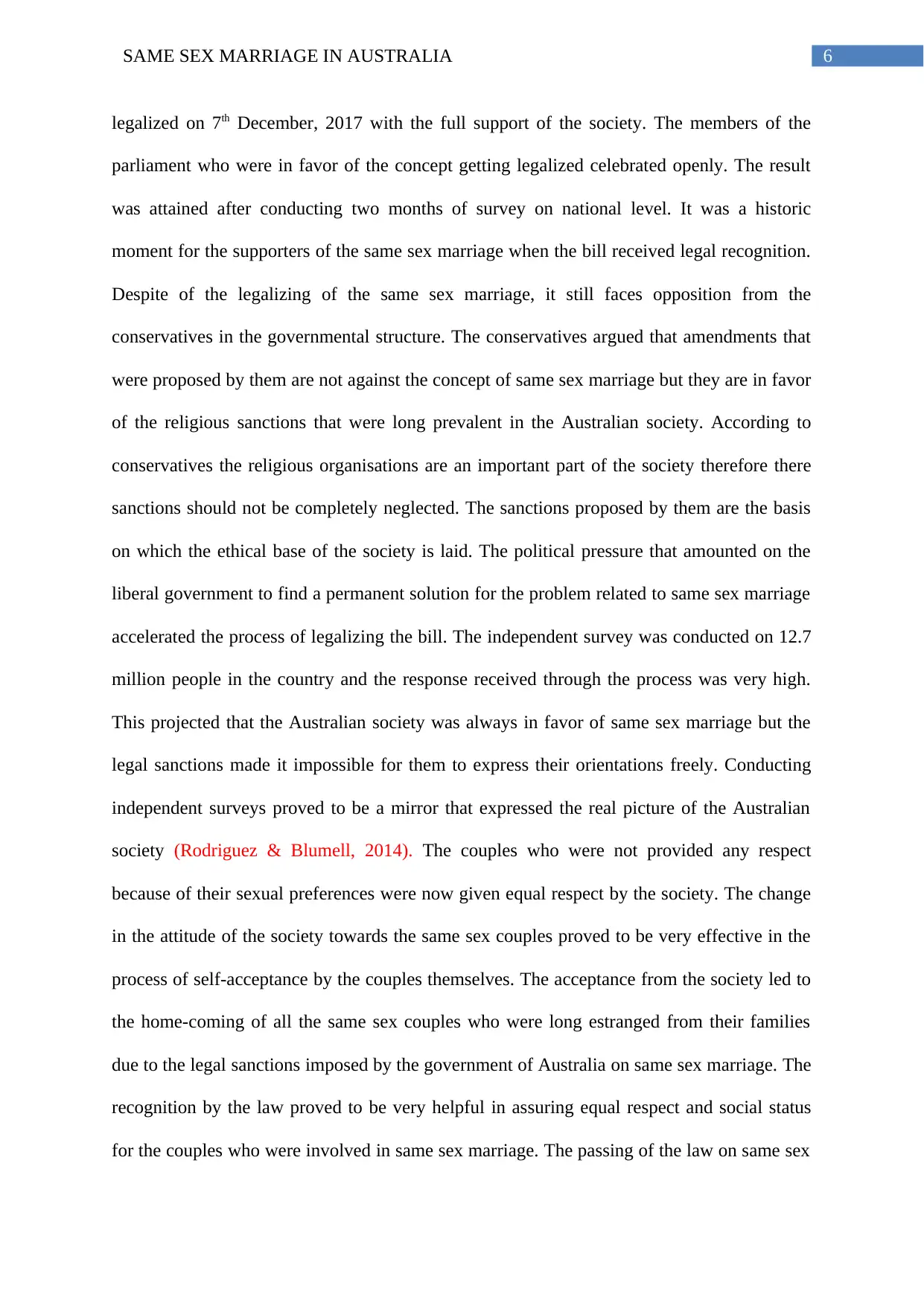
6SAME SEX MARRIAGE IN AUSTRALIA
legalized on 7th December, 2017 with the full support of the society. The members of the
parliament who were in favor of the concept getting legalized celebrated openly. The result
was attained after conducting two months of survey on national level. It was a historic
moment for the supporters of the same sex marriage when the bill received legal recognition.
Despite of the legalizing of the same sex marriage, it still faces opposition from the
conservatives in the governmental structure. The conservatives argued that amendments that
were proposed by them are not against the concept of same sex marriage but they are in favor
of the religious sanctions that were long prevalent in the Australian society. According to
conservatives the religious organisations are an important part of the society therefore there
sanctions should not be completely neglected. The sanctions proposed by them are the basis
on which the ethical base of the society is laid. The political pressure that amounted on the
liberal government to find a permanent solution for the problem related to same sex marriage
accelerated the process of legalizing the bill. The independent survey was conducted on 12.7
million people in the country and the response received through the process was very high.
This projected that the Australian society was always in favor of same sex marriage but the
legal sanctions made it impossible for them to express their orientations freely. Conducting
independent surveys proved to be a mirror that expressed the real picture of the Australian
society (Rodriguez & Blumell, 2014). The couples who were not provided any respect
because of their sexual preferences were now given equal respect by the society. The change
in the attitude of the society towards the same sex couples proved to be very effective in the
process of self-acceptance by the couples themselves. The acceptance from the society led to
the home-coming of all the same sex couples who were long estranged from their families
due to the legal sanctions imposed by the government of Australia on same sex marriage. The
recognition by the law proved to be very helpful in assuring equal respect and social status
for the couples who were involved in same sex marriage. The passing of the law on same sex
legalized on 7th December, 2017 with the full support of the society. The members of the
parliament who were in favor of the concept getting legalized celebrated openly. The result
was attained after conducting two months of survey on national level. It was a historic
moment for the supporters of the same sex marriage when the bill received legal recognition.
Despite of the legalizing of the same sex marriage, it still faces opposition from the
conservatives in the governmental structure. The conservatives argued that amendments that
were proposed by them are not against the concept of same sex marriage but they are in favor
of the religious sanctions that were long prevalent in the Australian society. According to
conservatives the religious organisations are an important part of the society therefore there
sanctions should not be completely neglected. The sanctions proposed by them are the basis
on which the ethical base of the society is laid. The political pressure that amounted on the
liberal government to find a permanent solution for the problem related to same sex marriage
accelerated the process of legalizing the bill. The independent survey was conducted on 12.7
million people in the country and the response received through the process was very high.
This projected that the Australian society was always in favor of same sex marriage but the
legal sanctions made it impossible for them to express their orientations freely. Conducting
independent surveys proved to be a mirror that expressed the real picture of the Australian
society (Rodriguez & Blumell, 2014). The couples who were not provided any respect
because of their sexual preferences were now given equal respect by the society. The change
in the attitude of the society towards the same sex couples proved to be very effective in the
process of self-acceptance by the couples themselves. The acceptance from the society led to
the home-coming of all the same sex couples who were long estranged from their families
due to the legal sanctions imposed by the government of Australia on same sex marriage. The
recognition by the law proved to be very helpful in assuring equal respect and social status
for the couples who were involved in same sex marriage. The passing of the law on same sex
Paraphrase This Document
Need a fresh take? Get an instant paraphrase of this document with our AI Paraphraser
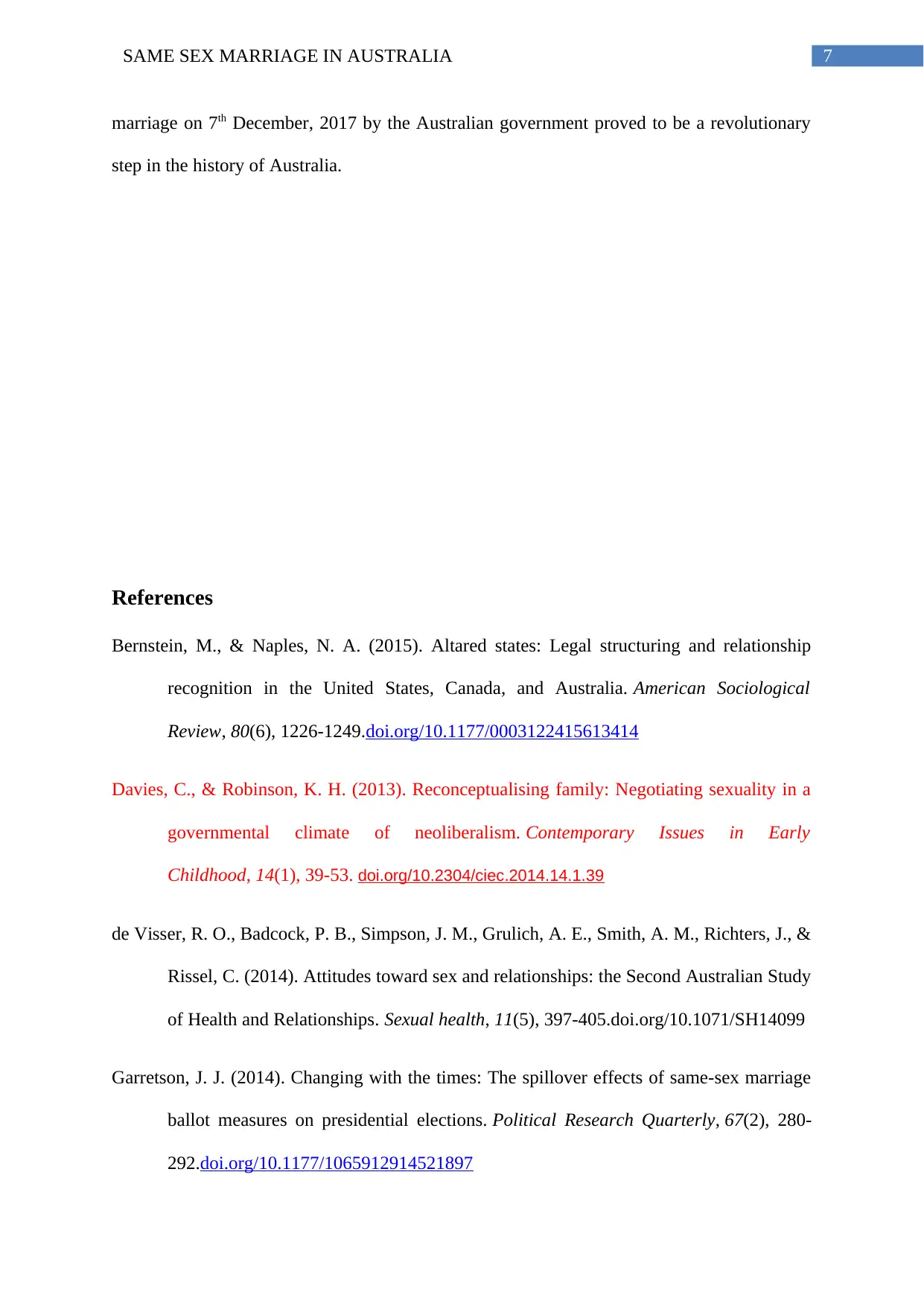
7SAME SEX MARRIAGE IN AUSTRALIA
marriage on 7th December, 2017 by the Australian government proved to be a revolutionary
step in the history of Australia.
References
Bernstein, M., & Naples, N. A. (2015). Altared states: Legal structuring and relationship
recognition in the United States, Canada, and Australia. American Sociological
Review, 80(6), 1226-1249.doi.org/10.1177/0003122415613414
Davies, C., & Robinson, K. H. (2013). Reconceptualising family: Negotiating sexuality in a
governmental climate of neoliberalism. Contemporary Issues in Early
Childhood, 14(1), 39-53. doi.org/10.2304/ciec.2014.14.1.39
de Visser, R. O., Badcock, P. B., Simpson, J. M., Grulich, A. E., Smith, A. M., Richters, J., &
Rissel, C. (2014). Attitudes toward sex and relationships: the Second Australian Study
of Health and Relationships. Sexual health, 11(5), 397-405.doi.org/10.1071/SH14099
Garretson, J. J. (2014). Changing with the times: The spillover effects of same-sex marriage
ballot measures on presidential elections. Political Research Quarterly, 67(2), 280-
292.doi.org/10.1177/1065912914521897
marriage on 7th December, 2017 by the Australian government proved to be a revolutionary
step in the history of Australia.
References
Bernstein, M., & Naples, N. A. (2015). Altared states: Legal structuring and relationship
recognition in the United States, Canada, and Australia. American Sociological
Review, 80(6), 1226-1249.doi.org/10.1177/0003122415613414
Davies, C., & Robinson, K. H. (2013). Reconceptualising family: Negotiating sexuality in a
governmental climate of neoliberalism. Contemporary Issues in Early
Childhood, 14(1), 39-53. doi.org/10.2304/ciec.2014.14.1.39
de Visser, R. O., Badcock, P. B., Simpson, J. M., Grulich, A. E., Smith, A. M., Richters, J., &
Rissel, C. (2014). Attitudes toward sex and relationships: the Second Australian Study
of Health and Relationships. Sexual health, 11(5), 397-405.doi.org/10.1071/SH14099
Garretson, J. J. (2014). Changing with the times: The spillover effects of same-sex marriage
ballot measures on presidential elections. Political Research Quarterly, 67(2), 280-
292.doi.org/10.1177/1065912914521897
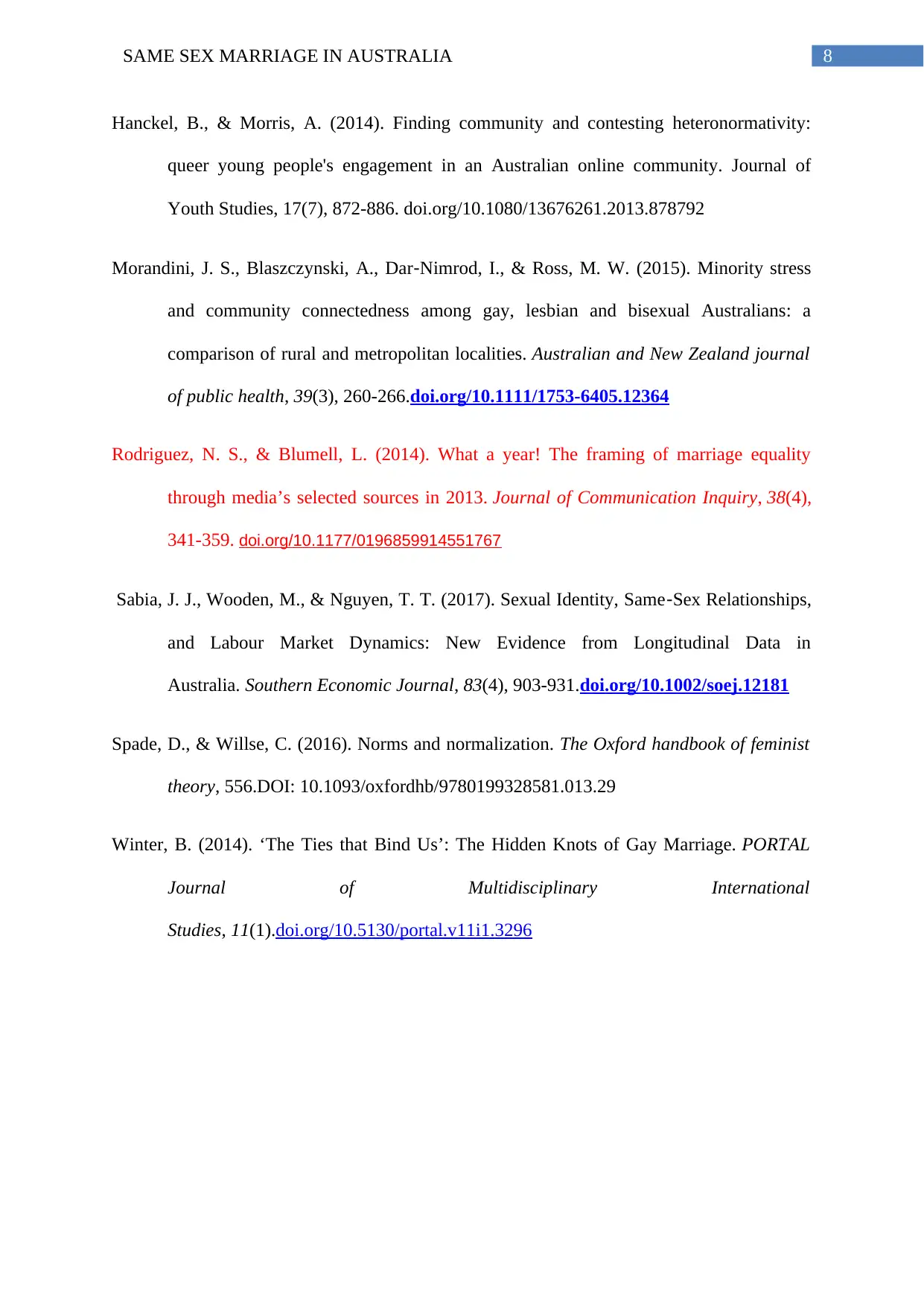
8SAME SEX MARRIAGE IN AUSTRALIA
Hanckel, B., & Morris, A. (2014). Finding community and contesting heteronormativity:
queer young people's engagement in an Australian online community. Journal of
Youth Studies, 17(7), 872-886. doi.org/10.1080/13676261.2013.878792
Morandini, J. S., Blaszczynski, A., Dar‐Nimrod, I., & Ross, M. W. (2015). Minority stress
and community connectedness among gay, lesbian and bisexual Australians: a
comparison of rural and metropolitan localities. Australian and New Zealand journal
of public health, 39(3), 260-266.doi.org/10.1111/1753-6405.12364
Rodriguez, N. S., & Blumell, L. (2014). What a year! The framing of marriage equality
through media’s selected sources in 2013. Journal of Communication Inquiry, 38(4),
341-359. doi.org/10.1177/0196859914551767
Sabia, J. J., Wooden, M., & Nguyen, T. T. (2017). Sexual Identity, Same‐Sex Relationships,
and Labour Market Dynamics: New Evidence from Longitudinal Data in
Australia. Southern Economic Journal, 83(4), 903-931.doi.org/10.1002/soej.12181
Spade, D., & Willse, C. (2016). Norms and normalization. The Oxford handbook of feminist
theory, 556.DOI: 10.1093/oxfordhb/9780199328581.013.29
Winter, B. (2014). ‘The Ties that Bind Us’: The Hidden Knots of Gay Marriage. PORTAL
Journal of Multidisciplinary International
Studies, 11(1).doi.org/10.5130/portal.v11i1.3296
Hanckel, B., & Morris, A. (2014). Finding community and contesting heteronormativity:
queer young people's engagement in an Australian online community. Journal of
Youth Studies, 17(7), 872-886. doi.org/10.1080/13676261.2013.878792
Morandini, J. S., Blaszczynski, A., Dar‐Nimrod, I., & Ross, M. W. (2015). Minority stress
and community connectedness among gay, lesbian and bisexual Australians: a
comparison of rural and metropolitan localities. Australian and New Zealand journal
of public health, 39(3), 260-266.doi.org/10.1111/1753-6405.12364
Rodriguez, N. S., & Blumell, L. (2014). What a year! The framing of marriage equality
through media’s selected sources in 2013. Journal of Communication Inquiry, 38(4),
341-359. doi.org/10.1177/0196859914551767
Sabia, J. J., Wooden, M., & Nguyen, T. T. (2017). Sexual Identity, Same‐Sex Relationships,
and Labour Market Dynamics: New Evidence from Longitudinal Data in
Australia. Southern Economic Journal, 83(4), 903-931.doi.org/10.1002/soej.12181
Spade, D., & Willse, C. (2016). Norms and normalization. The Oxford handbook of feminist
theory, 556.DOI: 10.1093/oxfordhb/9780199328581.013.29
Winter, B. (2014). ‘The Ties that Bind Us’: The Hidden Knots of Gay Marriage. PORTAL
Journal of Multidisciplinary International
Studies, 11(1).doi.org/10.5130/portal.v11i1.3296
1 out of 9
Related Documents
Your All-in-One AI-Powered Toolkit for Academic Success.
+13062052269
info@desklib.com
Available 24*7 on WhatsApp / Email
![[object Object]](/_next/static/media/star-bottom.7253800d.svg)
Unlock your academic potential
© 2024 | Zucol Services PVT LTD | All rights reserved.





